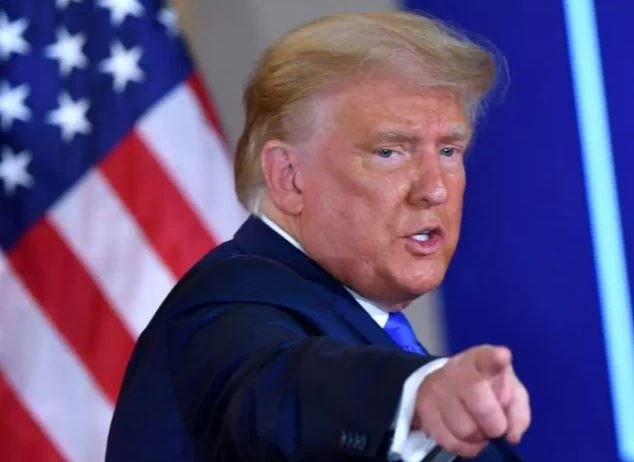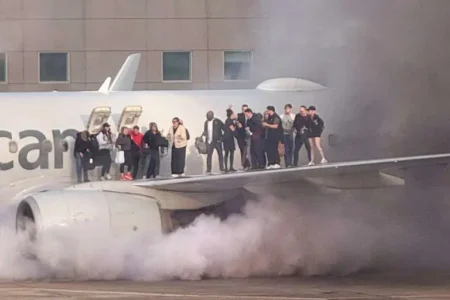Donald Trump announced 25% tariffs on foreign steel and aluminum ramping up his controversial attempt to boost the US economy by hiking taxes on imports from overseas.
The modified US duties will be enforced “without exceptions or exemptions”, the president declared, dashing the hopes of countries that hoped to avoid them.
Trump first imposed steep tariffs on foreign steel and aluminum during his first presidency. The action announced on Monday night ends exemptions granted to certain countries, and increases the duty rate on aluminum.
The changes are not due to come into effect until early March, however, according to a White House official – raising the prospect of the Trump administration brokering deals with governments seeking reprieve.
Countries including Australia have already been making their case and Trump later said he would give “great consideration” to Australia’s request for an exemption to the steel tariffs due to that country’s trade deficit with the US.
Trump first trailed his latest tariff actions on Sunday, adding that he would also announce a further set of reciprocal tariffs later in the week, drawing warnings of retaliation from trade partners.
“The steel and aluminum tariffs 2.0 will put an end to foreign dumping, boost domestic production and secure our steel and aluminum industries as the backbone and pillar industries of America’s economic and national security,” Peter Navarro, Trump’s top trade adviser, told reporters.
“This isn’t just about trade. It’s about ensuring that America never has to rely on foreign nations for critical industries like steel and aluminum.”
Trump will also impose a new North American standard requiring steel imports to be “melted and poured” and aluminum to be “smelted and cast” within the region to curb US imports of minimally processed Chinese and Russian metals that circumvent other tariffs.
Trump and his allies, who repeatedly claimed that tariffs could “Make America great again” when fighting to regain the White House, believe that higher taxes on imported steel and aluminum will help shore up US industrial heartlands.
The US president said he would announce plans to impose reciprocal tariffs on other countries over the next two days. He signed two proclamations as he spoke to reporters in the Oval Office: one ending waivers granted by Joe Biden to steel and aluminum tariffs instituted during his first term, and the other raising duties on both metals to 25%.
He also raised the prospect of future US tariffs on cars, semiconductor chips and pharmaceuticals from markets across the world.
Asked about the possibility of other countries retaliating against US tariffs, Trump said: “I don’t mind.”
Canada’s industry minister said the US tariffs were “totally unjustified”, with Canadian steel and aluminum supporting key US industries including defense, shipbuilding, energy and autos.
“This is making North America more competitive and secure,” François-Philippe Champagne said in a statement. “We are consulting with our international partners as we examine the details. Our response will be clear and calibrated.”
The European Commission said it saw no justification for the tariffs and said its president, Ursula von der Leyen, would meet the US vice-president, JD Vance, in Paris on Tuesday during an AI summit.
In South Korea, the industry ministry called in steelmakers to discuss how to minimize the impact of tariffs.
Ahead of a meeting with Trump on Wednesday, the Indian prime minister, Narendra Modi, was preparing to offer to cut Indian tariffs in a range of sectors that could boost US exports to the country, government officials in Delhi said.
Trump has previously called India a “very big abuser” on trade, and his top economic adviser Kevin Hassett singled out the country as having “enormously high” tariffs in a CNBC interview.
This latest wave of tariffs is different than the one imposed by the White House on China last week, which hit all goods traveling from the country to the US with an additional 10% duty. He also threatened Canada and Mexico with the same blanket tariffs, at higher a rate of 25%, only to agree to a one-month delay before pulling the trigger.
Trump signed proclamations that raised the tariff rate on aluminum imports to 25% from the previous 10% that he imposed in 2018 to aid the struggling sector. His action reinstates a 25% tariff on millions of tonnes of steel imports and aluminum imports that had been entering the US duty-free under quota deals, exemptions and thousands of product exclusions.
The proclamations were extensions of Trump’s 2018 section 232 national security tariffs to protect steel and aluminum makers. A White House official said the exemptions had eroded the effectiveness of these measures.
About a quarter of steel used in the US is from overseas, with Canada, Brazil and Mexico as the top providers. South Korea, Japan and Germany are also key markets.
China, hit by a 25% steel tariff during Trump’s first administration that was maintained under Joe Biden, is not a significant exporter of steel to the US. But it is the largest exporter of steel to the world, dominating the global market with typically cheaper products. Some countries then export their own steel products, at higher rates, to markets including the US.
Trump’s fixation with tariffs has alarmed economists, who have warned their imposition may derail his repeated promises to rapidly bring down prices for millions of Americans.
But Trump has defended his strategy, claiming they could raise “trillions” of dollars for the US economy – and that even the mere threat of import duties can prompt countries to bend to his will. “Tariffs are very powerful, both economically and in getting everything else you want,” he said last week.











